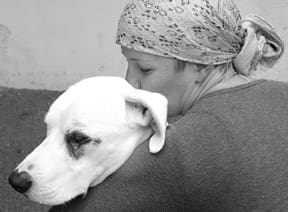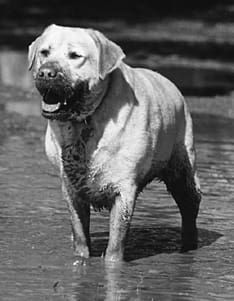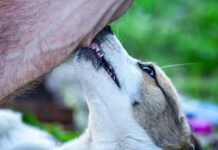Eavesdrop on a group of dog owners discussing their dogs, and along with a lot of brags about newly trained behaviors and hard-won trophies and titles, you’re likely to hear a fair number of complaints about the annoying things their canine companions do. Well guess what? If you could eavesdrop on a pack of dogs at the dog park, you might well hear a litany of things that humans do to annoy their dogs!
Of course, dogs can’t talk, and aside from a few animal psychics we can’t claim to really know what they’re thinking, but we can make some pretty good guesses. If we could take a survey, compile the results, and list our dogs’ top five pet peeves, I’m guessing here’s what they might tell us:

1.) They treat me like a monkey!
Dogs are canids; humans are primates. Our two species have hardwired behaviors that make us what and who we are. The physical differences are obvious – dogs have fur and tails, and walk on four legs. We are naked and tailless, walk on two legs, and have opposable thumbs.
The behavioral differences aren’t always as noticeable, but they are well-documented. To their credit, dogs are far better at observing, analyzing, and manipulating the behavior of humans than most humans are of dogs. For example, current thinking about the history of the dog-human relationship now holds that rather than humans deliberately domesticating dogs, it’s more likely that dogs adopted humans, recognizing early man’s leavings as a reliable source of food, with the boldest and tamest members of the dog packs self-selecting for ever-bolder-and-tamer genes in their pups. Eventually, Dog was sleeping at the hearth of Man.
Still, they are dogs, not furry, four-legged humans, and as dogs, they have an inherited package of social behaviors that differs significantly from ours. We approach other humans head-on, make direct eye contact, and reach out to shake hands, hug, and kiss. Dogs generally approach each other from the side, avoid direct eye contact unless they intend to challenge, and if one dog puts a paw “around” another, it’s probably an aggressive move (unless done in mutually agreeable play).
Yet we insist on imposing our primate greetings on dogs. Not just on our dogs, who might reasonably be expected to tolerate rude behavior from their own humans, but even on strange dogs we encounter. Watch any random group of humans greet dogs that they don’t know. From very young children all the way to senior citizens, the majority will try to pat dogs on top of the head, gaze meaningfully into their eyes, even hug and kiss them.
Even those of us who know better do this! I hug and kiss our dogs, especially Dubhy, the Scotty, who is most tolerant of my monkey-ness. I can’t help it – he’s so huggable! He puts up with my attentions in exchange for the pleasure of lying on his back in my lap and getting a tummy rub, which he adores. I used classical conditioning – associating the joy of tummy rubbing with the less desirable hugging – to get him to accept, perhaps even enjoy, human arms around his fuzzy body and human lips on the top of his head and the tip of his nose. I’m much more careful to use appropriate greetings with dogs I don’t know, however!
You have a couple of options if you want to avoid annoying dogs with primate social behaviors. With strange dogs, your best bet is to avoid direct eye contact, offer a hand slowly, palm up, and reach under the chin to scratch rather than over the head to pat, kneel to greet rather than bending over from the waist, and DON’T HUG OR KISS! With your own dogs, you can either avoid egregiously primate behavior, or condition your dog to enjoy pats, hugs, and kisses by associating them with really good stuff – like tummy rubs, treats, ear scratches, toys, and play.
Remember, this is not just about greeting. If your dog barely suffers your head-pats, and you think you’re rewarding him for a desirable behavior by patting him on the head, think again – you could actually be punishing him, thereby decreasing the behavior rather than reinforcing it. Watch him the next time you reach to pat his head. Does he close his eyes blissfully and lean into your hand? If so, then he really likes it! But if he moves away, flattens his ears, ducks his head or otherwise looks less than joyful, it’s time to rethink your primate behaviors.
2.)They leave me alone too often!
Canids and primates are both social species; it’s one of the reasons we get along with each other as well as we do. In addition to the need for food, water, and some amount of shelter from the elements, we share an inborn need for close and regular interaction with others from our social group.
My husband and I moved to Maryland from a state whose culture held the common view that dogs belong in the backyard, preferably in a pen. My husband, who was director of the city animal services division, was taken aback by the number of calls he got from owners asking for help catching their own dogs. In each case, the dog had escaped from his pen and, although still in a fenced yard, could not be recaptured by the owner. Paul finally asked one caller why he even had a dog, if all he did was keep it in a pen in the yard. The owner answered, “I just like looking out the window and seeing him there.”
Keeping a dog in a pen 24/7 falls woefully short of meeting a dog’s needs for mental and physical stimulation. I doubt there are many WDJ readers who would consider a pen in a yard to be an adequate environment for a canine companion. Still, I would bet that many otherwise responsible dog guardians fall somewhat short of meetings their dogs’ needs. If your dog is crated at night and lies around on his foam dog bed all day waiting for you to come home from work, you’d best be setting aside some quality morning and evening time for Rover.
An on-leash walk around the block is an exercise hors d’oeurve for many dogs. Barring physical infirmity or other frailty, every dog deserves a good aerobic workout – if not every day, at least every other day. If you don’t feel like a hike in the hills with your dog frolicking on a long-line, or off leash with a solid recall, at least give him a good round of Frisbee or tennis ball in the backyard on a reliably frequent basis. Not only will he be healthier, but it will help with behavior problems as well. A tired dog is a well-behaved dog.
While you’re at it, don’t forget mental exercise. When’s the last time you and Rover learned something new together? Maybe it’s time the two of you signed up for a class on freestyle or rally obedience. Other brainteasers? Find a good book on teaching tricks, or a copy of the “My Dog Can Do That” board game, and start having more fun with your dog while challenging canine and human brain cells.
Next time your dog brings you his leash or a toy, and says he wants to go for a walk or play with you, don’t dismiss him in annoyance and promise him a walk on the weekend. If you just want something to look at, get a picture of a dog and hang it on your wall. Life is short – play now!
3.) They ignore me when I’m good!
Dogs may not be able to articulate the principles of operant conditioning, but they understand them perfectly – especially the part about “Behaviors that are reinforced will increase.” The flip side of that says, “Behaviors that are not reinforced will decrease and eventually extinguish.”
We are a busy culture. We tend to ignore our dogs when they are behaving themselves, and pay attention when they are being difficult. By doing so, in essence we are punishing appropriate behaviors, and reinforcing inappropriate behaviors. That’s backward!
Dogs must find it frustrating when they perform a beautifully appropriate and rewardable behavior (such as sitting to greet you) and you are oblivious.

“Hey!” your dog thinks. “I’m sitting! Don’t I get a Click! and treat? Or at least a word of praise and a scratch behind the ear?” Preoccupied with planning dinner, or tomorrow’s budget meeting, you walk right past your sitting dog.
“’Scuse me,” your dog says as he puts his paws up on your $400 business suit and snags a thread. “Aren’t you supposed to reward me for sitting to greet you?”
“Not now, Rover!” you snap as you push him away.
“Well,” he sighs, “at least she spoke to me and touched me. I’ll have to try jumping up again next time.”
It’s easy to forget to pay attention to good behavior. You’re busy on your computer keyboard, and he’s sleeping quietly in the corner. He’s finally calm, and you don’t want to rile him up again. Just quietly croon to him, “Goooooood boy,” in a low voice. Or lean over and gently drop a treat in front of his nose. Make a pledge to notice (and reinforce) your dog’s good behavior at least three times a day. You’ll be surprised how easy it really is.
4.) Humans are so inconsistent!
Dogs don’t understand special occasions, or “just this once.” They do best with structure and consistency. If you let your dog up on the sofa today, don’t be surprised if he jumps up and makes himself at home tomorrow while you’re off at work. The best-behaved dogs are generally those who live in structured, consistent environments – where they can learn early on what works, and what doesn’t.
The best way to avoid confusing your dog with a lack of consistency is to set clear house rules and make sure the whole family follows them. Some of the things you may want to address in your family “Dog Rules” meeting might include:
• Is the dog allowed on any furniture? Some furniture? All furniture?
• Where will the dog sleep? In a crate? On someone’s bed? In whose room?
• When and where is he fed? Who is responsible for making sure he gets fed?
• Where is his bathroom? In the backyard? Anywhere in the yard, or in a designated spot? Who is his bathroom monitor?
• Who will train him? One person? The whole family? How do we make sure everyone is using the same training methods, philosophies, and cues?
• What games are okay to play? What are the “rules” of the games?
• What do we do about undesirable behavior? What if we “catch” him having an accident in the house? What if he tries to nip? What if he barks too much? What if he chews something? What if he chases the cat?
• Who will walk him? Exercise him?
Keep notes at the meeting, and write up the results. Post a list on the refrigerator of agreed-upon rules so everyone can remember to be consistent with the dog. If something isn’t working, discuss it and modify rules as needed.
Then remember that every time you are with your dog, you are training him. Make mental notes of behaviors he does that you like, and figure out how to consistently reinforce those. Make note of those you don’t like, and devise a plan to manage the behaviors so he can’t get rewarded for them. When he tries, divert him to a more acceptable, incompatible behavior. For example, if he jumps up, consistently reinforce sitting instead – he can’t jump up and sit at the same time.
The more consistent you can be with your reinforcements and your management, the sooner your dog’s world will make sense to him and the easier life will be for you both.
5.) Humans’ expectations are so unreasonable!
Imagine how upsetting it would be if your spouse announced one day that you were going to be his training partner for preparing to run the Boston Marathon – and you have bad knees and asthma. It’s not any different than if you decided you wanted your English Bulldog to start training for competitive agility – especially if his favorite activity is napping with you on your recliner. Certainly, a Bulldog could have fun doing agility, but if you expect him to outrun Border Collies, you’ll both end up upset and frustrated.
Your relationship with your dog will be much more rewarding for the two of you if you know and understand your dog’s talents and limitations, and work with them. If you have a Beagle or a Bloodhound, rather than being annoyed that his nose is always on the ground, get excited about a future in tracking. Maybe you can do Search and Rescue together, or develop a new career finding missing pets! If your Australian Kelpie drives you crazy chasing things that move, don’t lose your cool over your herding fool – get yourself a flock of sheep or Indian Runner ducks for her to round up and give her a meaningful job to do. Compatible cats may do, in a pinch.
Your Pomeranian may never win the Iditarod, but he could be a lovely freestyle partner, or the “size” dog on a flyball team. Be open to whatever gifts your dog has to share with you, and let them guide you to activities that you can find mutually rewarding. As Leslie Nelson, noted author and trainer, said at the 2004 Association of Pet Dog Trainers conference, “Appreciate (and love) the dog you have, not the one you wish you had.”
If you are successful at fixing the things you do to annoy your dog, you may be pleasantly surprised to find that he does fewer things to annoy you as well. Then, the next time you’re standing around with a group of dog owners who are complaining about their dog’s annoying behaviors, you’ll happily have nothing to contribute. Wouldn’t that be nice?





